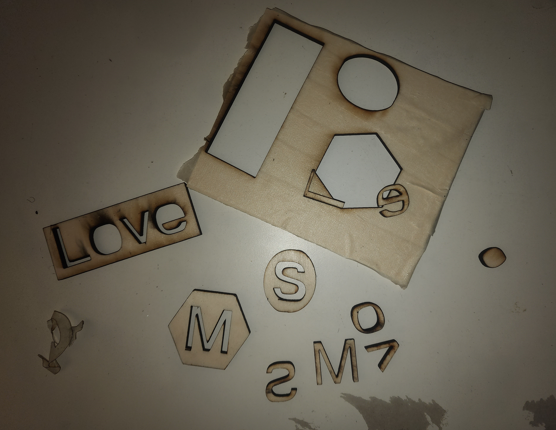How Does Laser Cutting Work?

What is Laser Cutting?
Have you ever seen those perfectly intricate designs cut out of wood or metal? Those are likely the work of a laser cutter, and let me tell you, it's a pretty amazing tool. I'm talking about a machine that uses a super-focused laser beam to cut through all sorts of materials.
How Does Laser Cutting Work? Step-by-Step
Step 1: Preparing Materials
Before cutting, you have to ensure that the material is suitable and safe for laser cutting. Certain materials, like PVC, can produce harmful gases when you cut them.
You have to position the material securely on the cutting bed properly so that it does not fall off or move.
Step 2: Generating The Laser Beam
Imagine a flashlight, but instead of a regular light bulb, it has a special glowing material. By pumping energy into this material, we can make it super bright. This bright light then bounces back and forth between mirrors, getting stronger each time. In the end, we have a super strong beam of light that can be used to cut through materials.
This is the simplest way I can possibly think of describing how the laser beam of a laser engraver or cutter is created.
Step 3: Focusing the Beam
We can then focus the beams energy into a small area using lenses or mirrors. This improves cutting precision and efficiency. Sophisticated systems can adjust the beam in real-time to correct any distortions that may occur during the cutting process.
These machines that are able to adjust on the fly are usually industrial type machines though.
Step 4: Setting Up Your Parameters
The different settings you will set or use will all be based on factors like material thickness and desired cut quality. These parameters include but are not limited to:
- Laser power
- Cutting speed
- Focal point
- Gas assist
- Air Assist
These settings determine the intensity and effectiveness of each cut. If one setting isn't made properly, there might be distortions in the final product. I mean, who wants to have a circular cutout that is shaped like an egg?
Step 5: Controlling The Motion of the beam
Your machine will have a limited space to work in. The motion of your machine will be programmed by you using your selected software. The software will allow you to control the exact movement of you beam along with the power.
Step 6: The Best Part - The Cutting Process
With all your preferred parameters set, the laser follows the programmed instructions that you set earlier to cut through the material.
The intense heat from the laser melts or cuts away the material along the desired path you set.
Step 7: Finishing Touches
After cutting, we will remove the finished parts from the cutting bed. This will allow them to cool down. Depending on the application, additional finishing steps like deburring or surface treatment may be necessary to prepare the parts for use.
Disadvantages of laser cutting
Laser cutting has many advantages but today we're going to start with the disadvantages. You might not see some of these as disadvantages but I am going to list them anyways.
- High Initial Investment
- Limited Thickness
- High Maintenance
- Material Limitations
- Slow Speed for Thick Materials
- Risk of Warping
- Hazardous Fumes
- Limited Flexibility
- High Energy Consumption
- Maintenance of Optics
Advantages of laser cutting
Precision Cuts: Laser cutting will allow you to accomplish awesome precision cuts.
Material Master: Wood, acrylic, metal, leather, and even some fabrics can be cut on a laser.
Clean and Efficient: No messy edges or leftover materials. I love that my laser engraver can also cut certain types of materials.
Automation Powerhouse: Once you have a certain design set, you can cut out that design easily over and over without fail as long as you maintain the machine.
What Can You Laser Cut?
The possibilities are almost endless! Here's a glimpse of what you can create with laser cutting:
- Signage & Displays
- Art & Décor
- Jewelry & Fashion
- Custom Parts & Prototypes
- Industrial Applications
- Packaging
- Aerospace Components
- Architectural Models
- Stationery & Invitations
- Educational Tools
Conclusion
You will no doubt find many uses for using a laser cutter. The best thing about laser cutters is how precise their cuts can be. This will allow you to make intricate signs or gifts for your friends, family, or even your business.
Related Articles
-
How to Laser Engrave Leather | Step-By-Step Guide
Can You Laser Engrave Leather?
How to Laser Engrave White Tiles Painted Black?
What Is The Best Low Cost Laser Engraver? My Opinion
How to Laser Engrave Acrylic with a Diode Laser: A Step-by-Step Guide
My Hands-On Review of the Monport 6-Watt Diode Laser Engraver
Laser Etching Glass
Laser Engraving A Photo | Full Guide
How Much Does Laser Engraving Cost
Is Laser Engraving Hard to Learn?
Why is laser engraving so expensive?
WHAT IS A LASER CUTTING MACHINE?
Top 7 Laser Engraving Business Ideas
10 Essential Safety Precautions for Home Laser Engraving Projects
Laser Engraving Cutting Boards | How To
Where To Buy Laser Cutting Materials?
Laser Engraving QR Codes
What Is DPI In Laser Engraving
How Much Is A Laser Engraving Machine